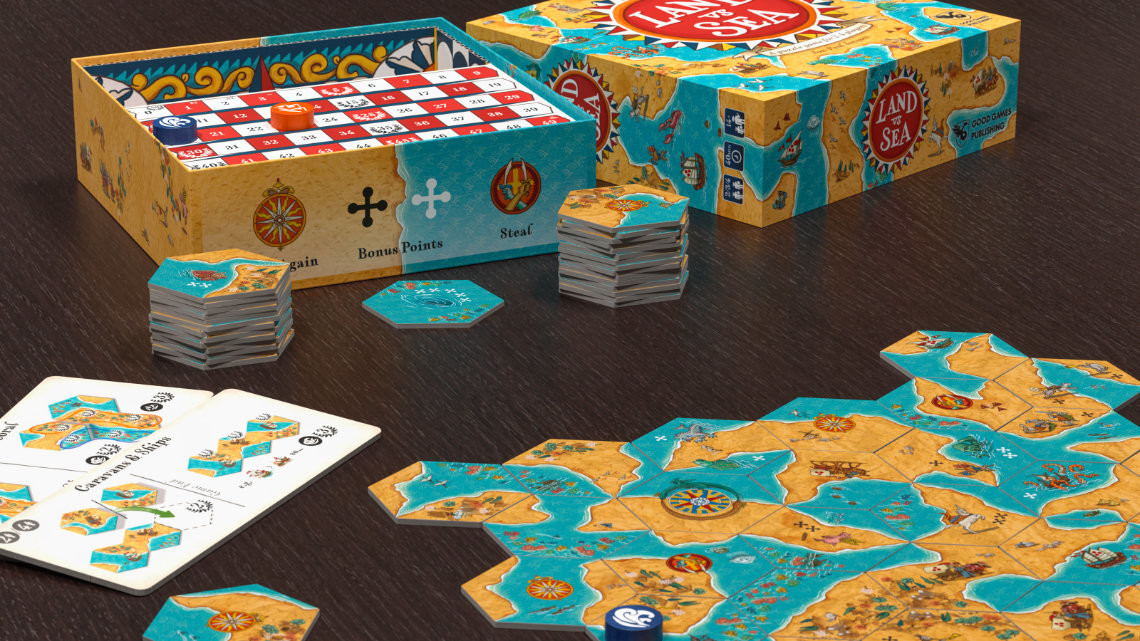
The Best Review for a Land vs Sea Game
Let’s check out this Land vs Sea Game Review
What is Land vs Sea?
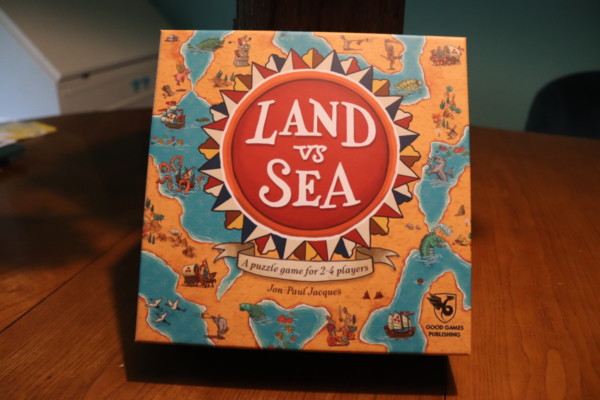
Today’s Land vs Sea Game Review is brought to you by Good Games Publishing. Land vs Sea describes itself as, “A beautiful 2, 3, and 4 player tile-laying game where you take turns placing tiles to build a map of land and sea areas filled with delightful details from historic cartography.”
It says the game is for 14+ but typically that means it has smaller pieces that pose a choking hazard, not because the difficulty requires them to be 14 years old. I think this game could be played by anyone over 7 years old.
The game says it takes 40 minutes but from my experience of several playthroughs it’s more around an hour.
[amazon box=”B08T1WBM3H”]
Who will enjoy Land vs Sea?
Anyone who enjoys piecing together puzzles or is a fan of tile-laying games such as Tsuro, Medina, Carcassonne, Hive, or Fjords may enjoy the simpler Land vs Sea.
Who will not enjoy this game?
Anyone who is not a fan of tile-laying games or wants more control over their strategy within tile-laying games.
How to Play Land Vs Sea Game:
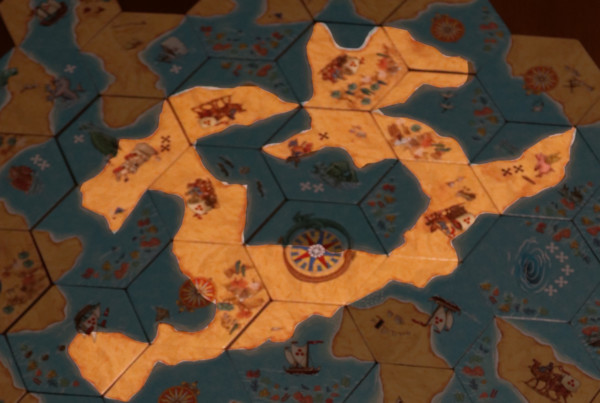 This is what an enclosed land segment looks like (I shadowed out the surrounding terrain to make it more obvious).
This is what an enclosed land segment looks like (I shadowed out the surrounding terrain to make it more obvious).
One player (or team) is the Land while the other side is the Sea. Each person gets 2 tiles that are double-sided. On your turn, you can place one tile wherever you’d like.
Whenever someone closes off either the land or sea so that it is completely surrounded by the other terrain, the player(s) who represent that enclosed terrain receives as many points as there are tiles that make up that enclosed terrain.
A Turn
If you have a tile with a compass on it that means you can play again by placing your 2nd tile where you’d like.
 This ‘Play Again’ symbol gives you a 2nd turn.
This ‘Play Again’ symbol gives you a 2nd turn.
Besides the “Play Again’ action, your tile may also have a symbol of swords clashing that means you can steal one of your opponent’s tiles.
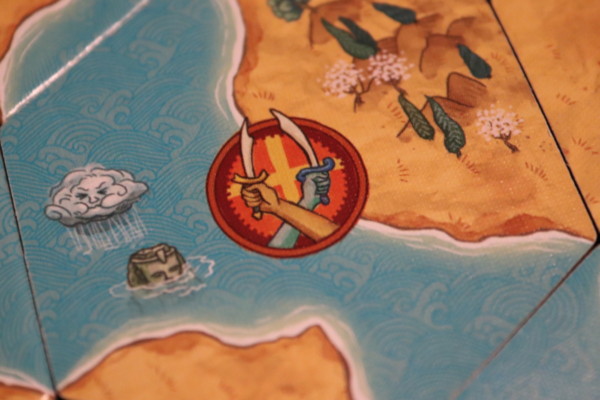 Get ready to be disliked by your opponent when you play this.
Get ready to be disliked by your opponent when you play this.
There are 2 stacks of tiles (which I like to call the ‘Tile Piles’) to pick from when your turn is over. After your turn you take however many tiles you need to make sure you are back to holding 2 again.
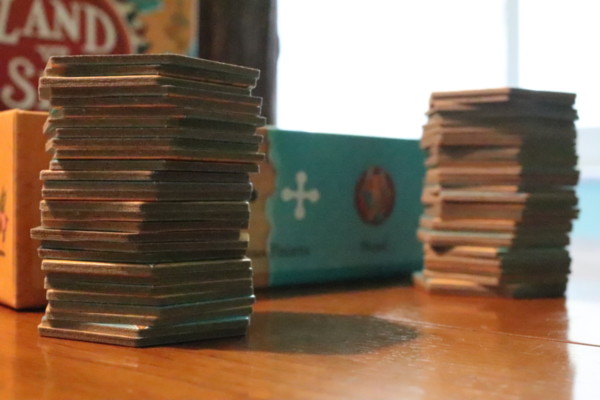 The Tile Piles
The Tile Piles
Scoring
You will first add up all the pieces in the enclosed terrain section.
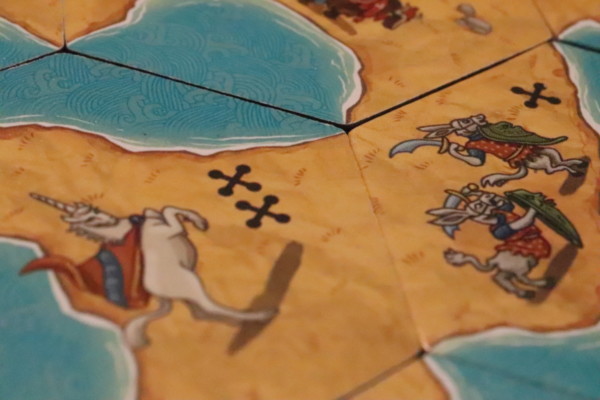 Each “X” symbol represents 1 bonus point.
Each “X” symbol represents 1 bonus point.
If there are any Bonus symbols on the enclosed tiles, the player who closed off that specific terrain receives the number of points that corresponds to the number of Bonus symbols on that terrain.
The box has the scoreboard built into it and you use a wooden token to move down the line onto the appropriate scoring number. At the end, after all tiles have been placed, the one with the most points wins.
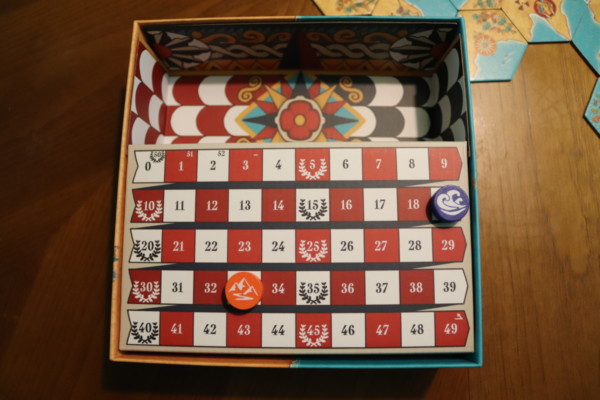
Artwork
When it comes to the art it is absolutely attractive, bright, and brilliant colors that portray that of antique maps from the past. However, thematically they are a little jumbled, spanning across what feels like different styles from Asian to Viking and Medieval to Greek Mythology. While this does not have any bearing on the game itself it makes the spirit of the game feel a little unharmonious due to the clashing of designs.
 Viking Ship; Asian Dragon, Fish, and Ship; Medieval Carriage with Knights
Viking Ship; Asian Dragon, Fish, and Ship; Medieval Carriage with Knights
I’m all for eccentric and I’m all for historical, but to my kids some could be better described as hysterical as one of the tiles has a medieval goat playing a trumpet out of its rear end while another shows a murderous, bloody bunny and why not?
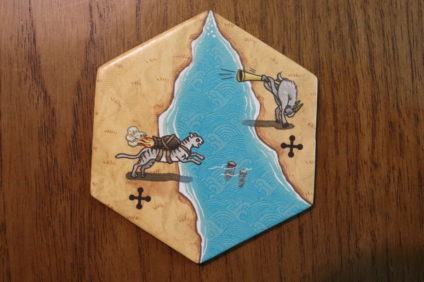
blowing hot air
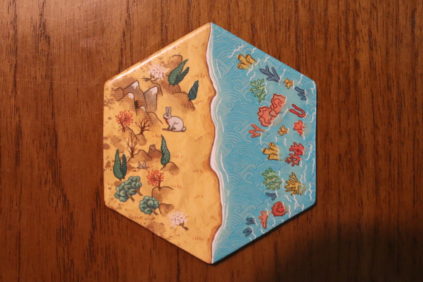
murder bunny
The Pros of Land vs Sea
Easy to Learn
This game is very easy to learn yet can take some time to master as you have a lot of ways you can score (depending on the scoring mode you’re playing). 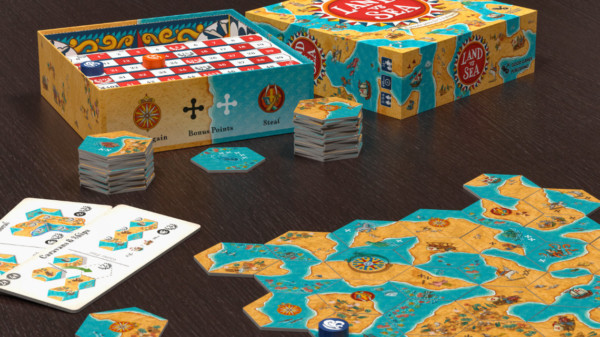
Not a Lot of Components
The box is small and very portable so it would make for easy traveling if you wanted to game while on vacation. For the most part, the game only comes with a few wooden tokens and 60 double-sided map tiles while the scoreboard is built into the inside of the box. The components are of great quality and the cardboard of the tiles is of a nice thickness.
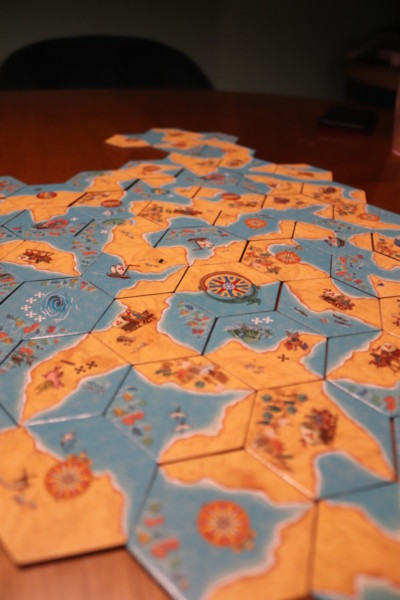 Puzzle Feeling
Puzzle Feeling
Being that you’re building and placing tiles in a way that creates a larger map in front of you gives a very similar feeling as to putting together a puzzle and watching it grow into a larger, more completed picture. So for puzzle enthusiasts, this game helps marry the two together.
Scoring Scalability
The great part about the scoring is that you can scale it as simple or complex as you please. Do you just want to count up how much land or sea is closed off? Maybe you want to add mountain ranges and coral reefs to that score? And maybe you want all of that but also at the end of the game total up even more points by seeing who had the larger caravans or shipping lanes. The world really is your oyster in Land vs Sea.
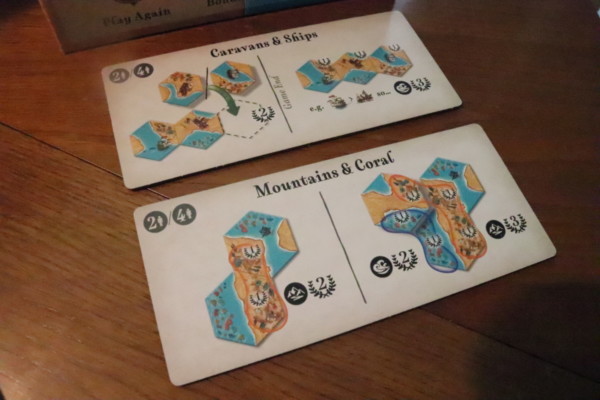 These boards help with understanding additional scoring options.
These boards help with understanding additional scoring options.
Strategy Scalability
With different scoring comes different strategies. Do you want to hold on to that mountain piece longer to expand upon the mountain range later or does that same piece have a design that will let you close off the land so as to collect points?
Other strategies are looking at the top of the tile stacks to see if any of the next tiles will help you later or stop your opponent from gaining an advantage.
The Cons of Lands vs Sea
Tile Piles can be looked at
Since we’re on the topic of taking tiles from the stacks, one place that strategy occurs is oddly enough when picking your random tiles. How it works is the tiles are in two stacks and you can pick from whichever ones you want. However, there’s more going on here than it seems. Do any of the two top tiles have something you’re looking for like, is there a ‘Play Again’ or Steal’ action on one? Does one hex’s side better fit what you’re looking for? This is where I had a few issues.
Due to each tile being double-sided you’re obviously only getting half of the information, which is fine, but when you take one that has an action (‘Play Again’ or ‘Steal’) showing at the top, your opponent also knows that you have one worth stealing and can watch which of the two tiles it is (even if you flip it over to hide it as this still gives them a chance to catch which one it was or at a very least they have a 50% chance of guessing which one it is).
Also, if you’re playing this game with people who are new to it, they may not realize to look at the tiles at the top to see if any could help them close off areas for points or strategy. So it’s crucial you explain that to them.
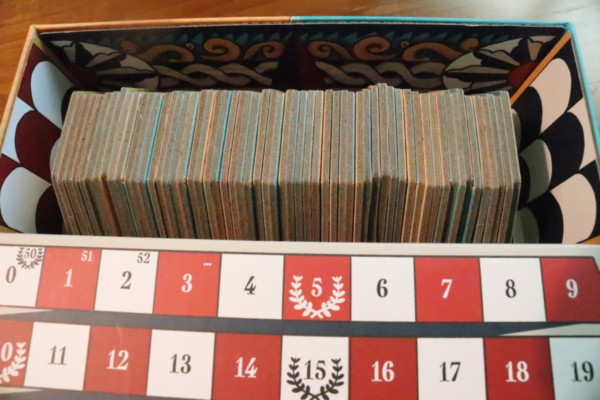 This is how the tiles are packed away but can also be an alternative to the Tile Piles so to bring a little more leisure to the already very quiet gameplay.
This is how the tiles are packed away but can also be an alternative to the Tile Piles so to bring a little more leisure to the already very quiet gameplay.
That said, some people may not want to have all this strategy due to the peaceful nature built into the game so I came up with something called ‘Leisure Mode’ where you leave the hexagons in the box, the way they are packed away, and players can take from either side. Although this would make the game go from semi-random to a more full-random mode, this would also help to avoid letting opponents see what abilities you possess while also eliminating the possible imbalance of some players strategizing while others may not be as experienced in the game’s strategies. That said, being a little more leisurely would also lean into its more puzzle roots making it more thematic.
Scoreboard adds pressure
Although it’s convenient to have the scoreboard built into the box, the score being so front and center takes away from the game’s otherwise chill feeling. To add a little more relaxation to my earlier suggestion of ‘Leisure Mode’ this game may be better served using the old-school way of keeping points where you just write scores down on a pad of paper and add it all up at the end. This could help players make the best moves possible without one feeling like they’re too far behind while also making it harder for someone to just play defensively.
Defensive Loop-Hole
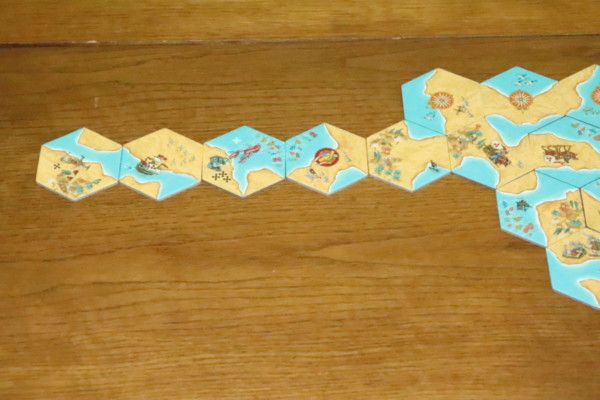 Another reason not to know the specific score is that I found a possible loophole. Once I knew I had a lead in the game I was able to just keep building a long line of single hexagons so as to play defensively, making it near impossible for my opponent to ever close off what needed to be closed, essentially buying time and securing my win. Nothing in the directions, from what I saw, said I couldn’t do that but it did make us develop a house rule where once the first tiles were set there could no longer be a single line of hexagons spanning more than 3 tiles.
Another reason not to know the specific score is that I found a possible loophole. Once I knew I had a lead in the game I was able to just keep building a long line of single hexagons so as to play defensively, making it near impossible for my opponent to ever close off what needed to be closed, essentially buying time and securing my win. Nothing in the directions, from what I saw, said I couldn’t do that but it did make us develop a house rule where once the first tiles were set there could no longer be a single line of hexagons spanning more than 3 tiles.
Hex Perplex
Since we’re talking about the game’s tiles, I’m not sure why but three of them have the Actions (‘Play Again’ and ‘Steal’) on both sides of the hexagons. This makes it impossible to hide from your opponents, since they’re exposed in the game, and thus results in a greater chance of them getting stolen. I found it odd that only three tiles were printed this way.
Limited Tiles in Hand
Although there can be some strategy in the game, with only two tiles (and sometimes only one if the other was stolen already) you are extremely limited by what you can plan out and actually accomplish. Thus, eliminating a lot of strategy on the tile placing portion of the game.
Experienced Players Preferred
Even though anyone new can jump in, this game does favor those who have played it before as they’ll know what to look for in order to score the maximum amount of points.
Final Thoughts on Land vs Sea Game Review
Because it takes looking at the game like a puzzle, your brain is constantly trying different configurations, both when it’s your turn and when it’s not, so be prepared for a very quiet game. This can either make it feel like it takes longer to play and/or it can feel very peaceful while doing so.
One strategy I like is the two abilities (‘Play Again’ & ‘Steal’). Sometimes it might be better to play the other side of the hex that doesn’t have those symbols but at the same time, it may be better to play the symbol now and get another piece later hoping you can make the move you want to before your opponent. What will you do?
Note to my fellow OCD players, you’ll want to keep cleaning up the hexagons just to have them all shift every time a new tile is laid down. Try to just let it go (I know, easier said than done).


